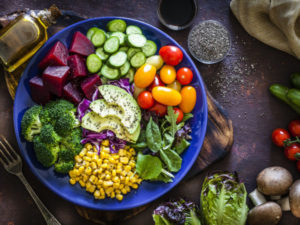Healthy eating is not boring! However a lot of folks are confused about what to eat when it comes to adopting a healthy diet. Lot of us think carbohydrates are bad for our body which is not true. Today, we are going to discuss about what is healthy eating. Eating healthy does not mean eating less. While adopting a healthy diet, your plate should have a variety of foods that are nutrient dense. Before we move ahead, it is important to understand nutrients.
Nutrients are divided into two categories macronutrients & micronutrients
Macronutrients- they have to be consumed in larger amounts:
- Protein: Help in building strength & muscle repair & recovery
- Carbohydrates: Provides you energy to take care of daily activities & improve physical performance. You can find more information about carbohydrates here.
- Fats: Carry fat soluble vitamins & helps in biological functions such as growth & development. You can find more information about fat here.
Micronutrients- they are needed in smaller amounts
- Vitamins
- Minerals
Healthy foods are rich in micronutrients- Vitamins & Minerals & low in refined/processed sugar, sodium & trans fat. Junk foods tend to have high quantity of sodium, salt & bad fat & less of fibre & micronutrients. You are not required to follow a specific diet to be healthy. Every food a purpose. Fitness is all about maintaining balance.
Processed vs Whole Food
Processed foods are low in fibre & micronutrients & tend to high in additives & preservatives, sugar & sodium. Your focus should be consume less of processed foods. Some of foods you should avoid include:
- Sugar candies
- Chocolate bars
- Dried fruits
- Packaged bacon
- Cereals
- Chips
- Junk stuff such as French Fries, Burgers, high fat mayonnaise
- Cheese
- Packaged condiments
Whole foods are minimally processed & are rich in Vitamins & Minerals. They should be part of your daily diet. Here is the list of whole foods:
- Nuts.
- Wild Fish
- Fruits & Veggies
- Whole grain foods
- Eggs & Meat
- Foods rich in fibre
So what should be part of your healthy plate?
- Vegetables– This should be 50% of total food items on your plate. These are rich in fibres & give your body plenty of micronutrients. They are are low in sugar so it keeps your blood sugar level under control. You can add some healthy fats such as Olive oil( for more details on why olive oil is best for cooking, read my blog ) & Peanut Butter that are rich in Omega-3 & Omega-6 fatty acids( You can find more details about Omega-3 & Omega-6 fatty acids here).
- Whole grain /Legumes– This should be 25% of total food items on your plate. Whole gain & legumes are rich in fibre & protein which has minimal impact on your blood sugar. You can consume whole-wheat bread, brown rice, beans, lentils & chickpeas.
- Quality protein-This should be 25% of total food items on your plate. Quality protein will keep your muscles, skin & bones healthy. Try foods like fish, eggs, chicken, meat, tofu & lentils( if you looking for plant based protein).
Meal Timing
Your meal plate would differ depending on when you are having the meal. What you consume in post workout meal would be entirely different from what you would consume for Lunch. For instance, on rest day your diet would have more fibre. Similarly, if you are not active for a few hours, you would prefer having less of carbs.
Fitness journey is all about maintaining a balance. It is about curating a sustainable nutrition that suits your lifestyle. It is ok to have a cheat meal once a week. You are what you eat. Remember this when you choose your next meal.
